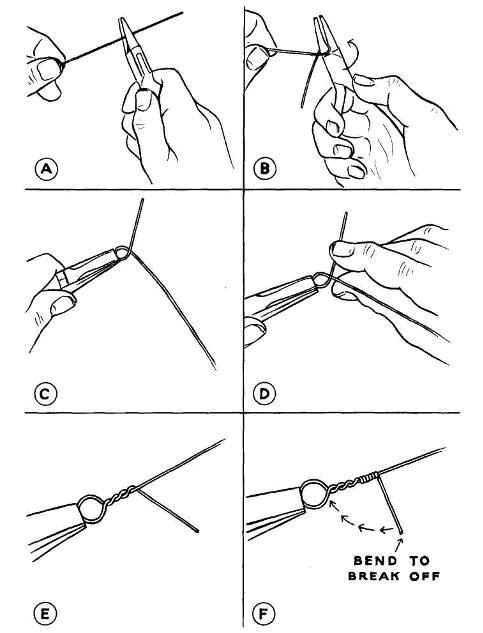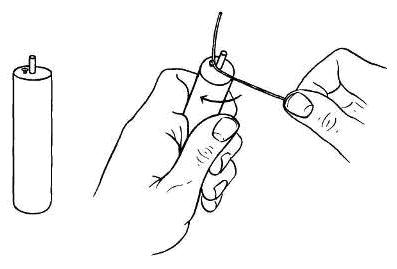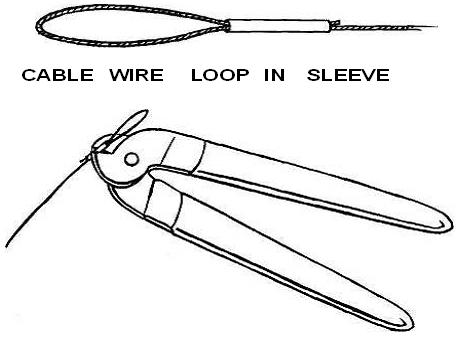|
Wire LeadersMake Your Wire Leaders
|
In other words, if you want a wire leader 12 in. long with an eye on each end you will have to start with a section of wire at least 17 or 18 in. long.
The longer the end you allow the easier it will be to work with. Experiment at first to see how long a piece you will need; after that, cut all the wire pieces the same length. Use diagonal pliers to cut the wire into the proper lengths.

To form the eye, grab the wire about two inches from the end with round nose pliers (A) and twist the pliers to the right to form a loop (B). Refer to illustration above.
Next, grab the end of the loop or eye with a pair of flat nose pliers (C). Hold the wire or shift it so that the short end overlaps the main wire on your side.
Now, using the right thumb and index finger, hold and twist the two wires at the point where they cross to the right (away from you), as shown in (D). Keep twisting the wire so that both of them interlock for several turns (E).
Then make several straight twists of the wire so that it looks as in (F). The remaining short length of wire should be at right angles to the main wire. To break it off, simply bend it sharply toward the eye, then back, then once again and it will break off clean.
This is important, because if you use pliers to clip it off it will leave a short, sharp stub which will cut your fingers.
Instead of using pliers to form the eye of the wire leader you can make up a small, handy jig to do this. Just get a dowel or broomstick handle or similar round wood and cut off about three inches.
Then drill a hole in one end so that you can drive in a nail. The thickness of the nail will depend on the size of the eye you want. For small eyes use a thin nail, and for the larger eyes use a thicker diameter nail.
In fact, it's a good idea to make up two or three jigs of various diameter nails for making different-sized loops. After this nail is driven into the center of the wood, take a small screw and screw it in next to this nail, about 1/16 in. away.
To form an eye in a wire, simply place it between the nail and the screw and twist it. The jig and how it is used is shown in the illustration below. Of course, the jig does only part of the job.

After you remove the wire from it you complete the eye by making the twists described above.
The other kind of wire used for making wire leaders is the cable type, usually twisted or braided from many fine strands of stainless steel. This cable wire is very flexible and doesn't kink as readily as the single-strand wire.
It comes bare or covered with nylon. To use this wire for leaders you need special crimping pliers and brass or copper sleeves, both of which are shown here.

To make a loop or eye, slip the end of the wire through the sleeve until it protrudes about an inch and a half on the other end. Then double the end of the wire back through the sleeve to form the loop or eye.
The sleeve is then pinched or crimped with the crimping pliers. When using nylon covered cable it's a good idea to remove the nylon at the point where the sleeve covers it.
If you want a swivel or snap on the end of the leader, slip it on the loop or eye before you double the wire into the sleeve. Such wire leader kits with the pliers, sleeves, and cable wire can be ordered by mail, and can also be bought in many fishing tackle stores.
|
| Freshwater Fishing | Bass Fishing | Saltwater Fishing | | Fishing Spoons | Fishing Spinners | Fishing Jigs | | Sinkers | Making Fishing Leaders | Hand Tools | | Link To Us | Contact Us | Preferred Partners | About This Site | | Site Map | |
| Back to Top of Wire Leaders |
Make-Your-Own-Fishing-Lures.com
© 2004 Make-Your-Own-Fishing-Lures.com. All Rights Reserved.



